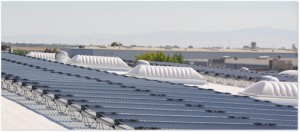Solyndra plans bankruptcy filing in blow to U.S. solar industry


The news is doubly unsettled considering the fact that Solyndra has snagged some pretty high profile commercial installations, including the Qwest field in Seattle, AND it had arranged a massive $535 million loan guarantee program with the U.S. Department of Energy. This collapse will be scrutinized up and down for sure, and likely will emerge as an embarrassing campaign issue for President Barack Obama, who visited Solyndra. In mid-July, House Republicans called for close scrutiny into how Solyndra was picked for the loan guarantee, especially since the company's IPO was pulled right after the deal was announced.
The Fremont, Calif.-based company publicly pinned its troubles to several factors, including its inability to ramp production as quickly as "larger foreign manufacturers," price compression and vanishing credit for financing solar systems.
In a statement, Solyndra President and CEO Brian Harris said:
"We are incredibly proud of our employees, and we would like to thank our investors, channel partners, customers and suppliers, for the years of support that allowed us to bring our innovative technology to market. Distributed rooftop solar power makes sense, and our customers clearly recognize the advantages of Solydra systems. Regulatory and policy uncertainties in recent months created significant near-term excess supply and price erosion. raising incremental cash in this environment was not possible. This was an unexpected outcome and is most unfortunate."
Some will doubtless use this development -- not exactly unexpected -- to build a case against future clean tech investments, at least as far as public-sector money is concerned. Others will cite it as evidence that America can ill afford to cut that funding or risk seeing other nations take the lead in renewable energy technologies.
Either way, American workers lose out. Again.
As for Solyndra customers, the company says the technology will generate power for "decades," but I am sure that will be little comfort when something needs to be repaired or replaced on one of the 1,000 rooftops that Solyndra has penetrated. The company's installed generating capacity was nearly 300 megawatts.